Superliga 2018/19 Review: Belgrano
Categories: Competition Analysis
| Superliga 18/19 Record | Won 4, Drawn 12, Lost 9 (24 points) |
| Superliga 18/19 Position | 22nd |
| Relegation Average | 1.097 (90 points/82 matches) |
| Relegation Position | 25th (Relegated) |
| Copa de la Superliga Result | Lost in First Round to Lanús (4-3 agg) |
| Goals Scored (own-goals not included) | 16 (12 open, 2 set-piece, 2 penalty) |
| Goals Allowed (own-goals not included) | 22 (17 open, 4 set-piece, 1 penalty) |
| Leading Goal Scorer | Leonardo Sequeira, Federico Lértora, Juan Brunetta, Maximiliano Lugo, Matías Suárez (2 goals) |
| Leading xG | Leonardo Sequeira (3.41 xG) |
| Leading xA | Juan Brunetta (1.85 xA) |
| Primary Goalkeeper | César Rigamonti (0.82 GA/90, -0.2 GAAx) |
| Team Disciplinary Record | 66 yellows, 8 reds |
At the beginning of the season, Belgrano were just outside the relegation zone thanks to a strong mid-table finish in 2017/18. They needed at least 1.2 points per game to ensure that they would stay safe, but after matchday 8 they never surpassed the 1.0 ppg mark. Belgrano’s defense wasn’t terrible; after all, they did achieve 11 clean sheets in the league. But eight of those clean sheets were goalless draws, and in only three matches did el Pirata score two or more goals (won them all). Add in the four 1-1 results, and you arrive at 12 winnable matches that finished as draws. If Belgrano had found an another goal in two of those matches, they would still be a Superliga side in 2019/20.
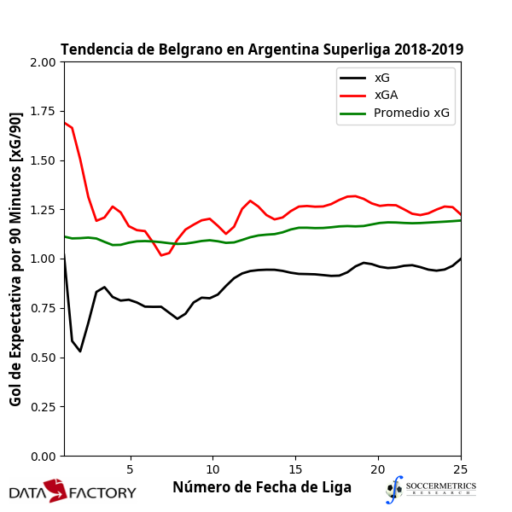
Managers: Belgrano had two managers in 2018/19. The first was Lucas Bernardi, who managed the team for the first eight matches until the clásico loss to Talleres, and Diego Osella, who was in charge for the club’s last seventeen. The verdict on Bernardi’s performance was that his teams were slightly worse than expectations in offense and defense, which contributed to a 0.875 ppg rate. Osella made more lineup changes with every matchday than Bernardi (2.53 rotations/match vs 1.63 rotations/match), and even though the team allowed much fewer goals relative to expectations, they scored much fewer goals than expectations as well. That combination makes it difficult to score three points with regularity, and the resulting 1.0 ppg fit Belgrano’s performance level.
Formations: Under Bernardi, Belgrano were more likely to play a 4-4-2 with two holding midfielders or a diamond. Federico Lértora was one of the holding midfielders, in some matches positioned behind the defenders and in others given more freedom to move forward. Here is an example for the match against Aldosivi in matchday 6:
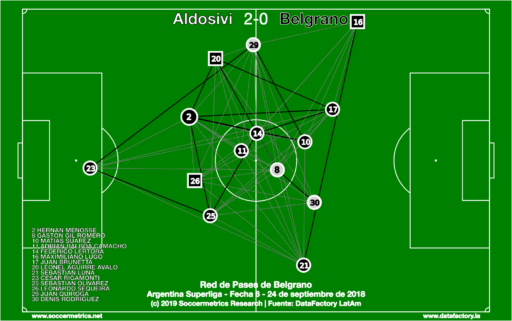
El Pirata under Osella had some more tactical flexibility. Sometimes they would play 4-4-2, other times they put out a 4-1-4-1, but the constant was Lértora in a holding midfielder role. Marcelo Meli and Maximiliano Lugo played important roles in the passing network, but they were more often connected to each other than they were to Lértora. Here is an example from the match against Boca in matchday 18:
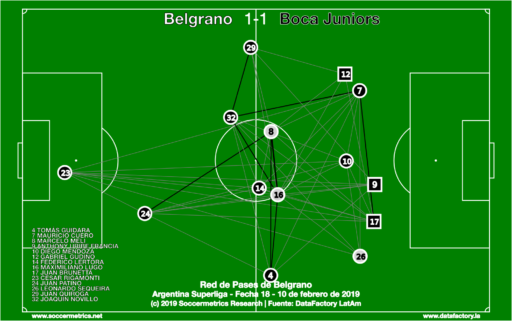
Most of the Belgrano players with high centrality values in the passing network played on the left side, such as Meli, Lugo, and Juan Quiroga. Lértora, who played more central, had a centrality metric of 0.30, and Tomás Guidara, who played on the right, had a centrality of 0.31.
Compared to the rest of the division, Belgrano’s possession numbers were poor. They had the third-fewest total possessions (40.0) and were on the ball the fourth-fewest amount of time (21.8 minutes). They did have the second-highest percentage of possessions with at least one shot, but that translated to 6.4 possessions with a shot. Combine that with Belgrano’s conversion rate, and the result is a very low scoring side. Defensively, Belgrano allowed more possessions, time on-ball, and possessions ending in a shot, but the xGA per possession was actually very low. Their xGA/possession was almost identical to Racing’s and was bettered only by Defensa y Justicia, Unión, and Boca Juniors. If only they could convert goals, they might have stayed a Superliga team.
Expected Play: As much as Belgrano struggled to create scoring chances, their conversion rate made it even more difficult to win matches. Belgrano were third-worst in total expected goals (26.7), fourth-worst in xG per shot (0.116), and third-worst in xG/90 (1.00).
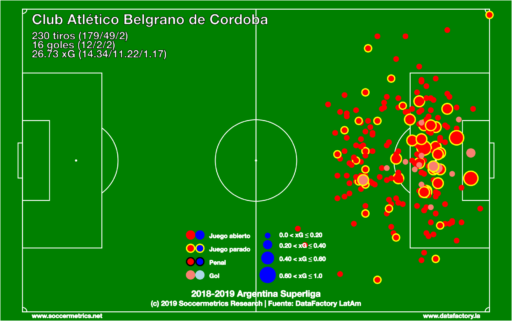
Belgrano’s defensive xG statistics were actually quite good. Their total xGA (32.8) and xGA/90 (1.22) were right in middle of all Superliga sides, but the actual number of goals allowed were the fifth-lowest in the top flight. Only Boca Juniors and Racing Club saw a lower percentage of shots converted against them.
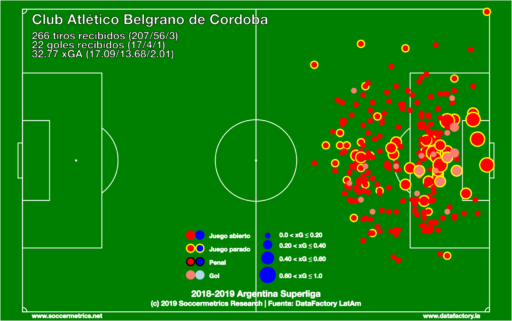
At an individual level, Federico Lértora and Leonardo Sequeira led Belgrano in expected goals with 3.48 and 3.41 xG, respectively. Juan Brunetta and Lértora led in expected assists with 1.85 and 1.62 xA, respectively, and Brunetta and Maximiliano Lugo led the team in expected assists per 90 minutes. César Rigamonti was the only goalkeeper used in the championship and he achieved an xGA/90 of 0.83 against an actual GA/90 of 0.82, which was good for -0.2 GAAx (goals allowed above expected).
Best Match: Belgrano 3-0 Patronato in matchday 22. In a relegation six-pointer, el Pirata gave their best effort in which they not only took full advantage of set plays, they also restricted their opponents to low-percentage chances (and just one in the penalty area).
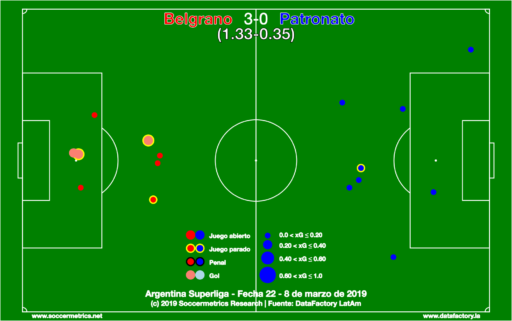
Worst Match: Without a doubt, Talleres 3-0 Belgrano in matchday 8. An abject performance that marked the end of the Bernardi era.
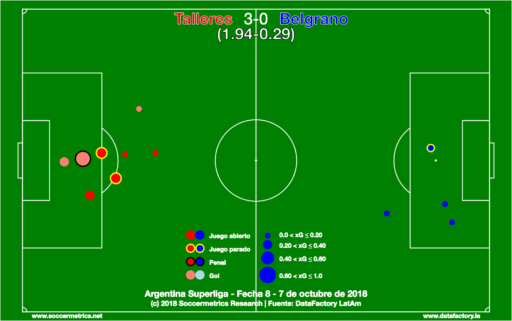
Best Player: In a side in which the leading goalscorer had two goals, it’s difficult to designate a forward player as best of the season. César Rigamonti, who was fifth among all Superliga first-choice goalkeepers in goals allowed above expected, was part of the reason why Belgrano allowed so few goals. In the end I’ll give best player to Federico Lértora, who led the team in xG, tackles, fouls, and yellow cards.
This review has been prepared with match event data supplied by DataFactory Latinoamérica.

